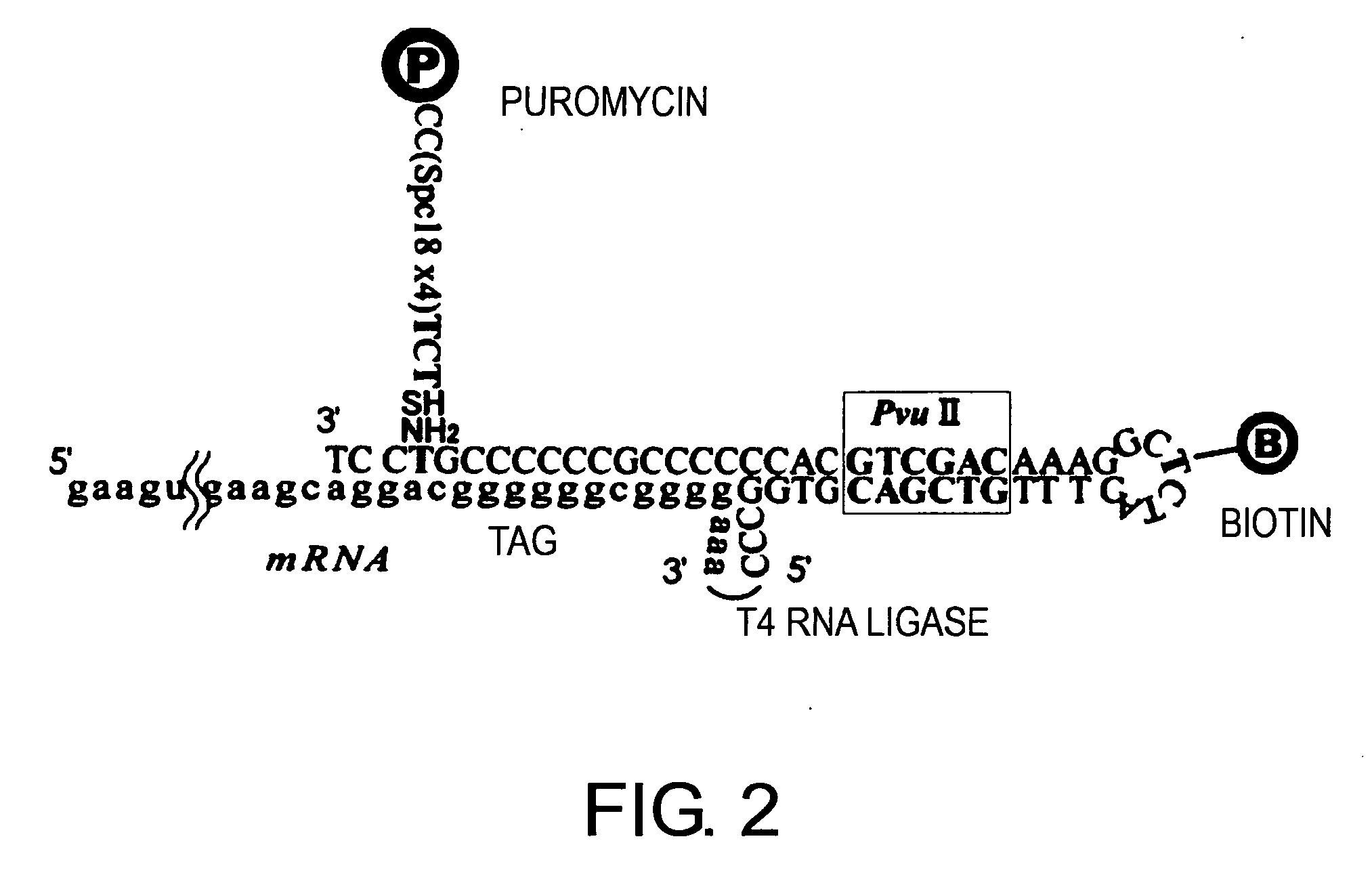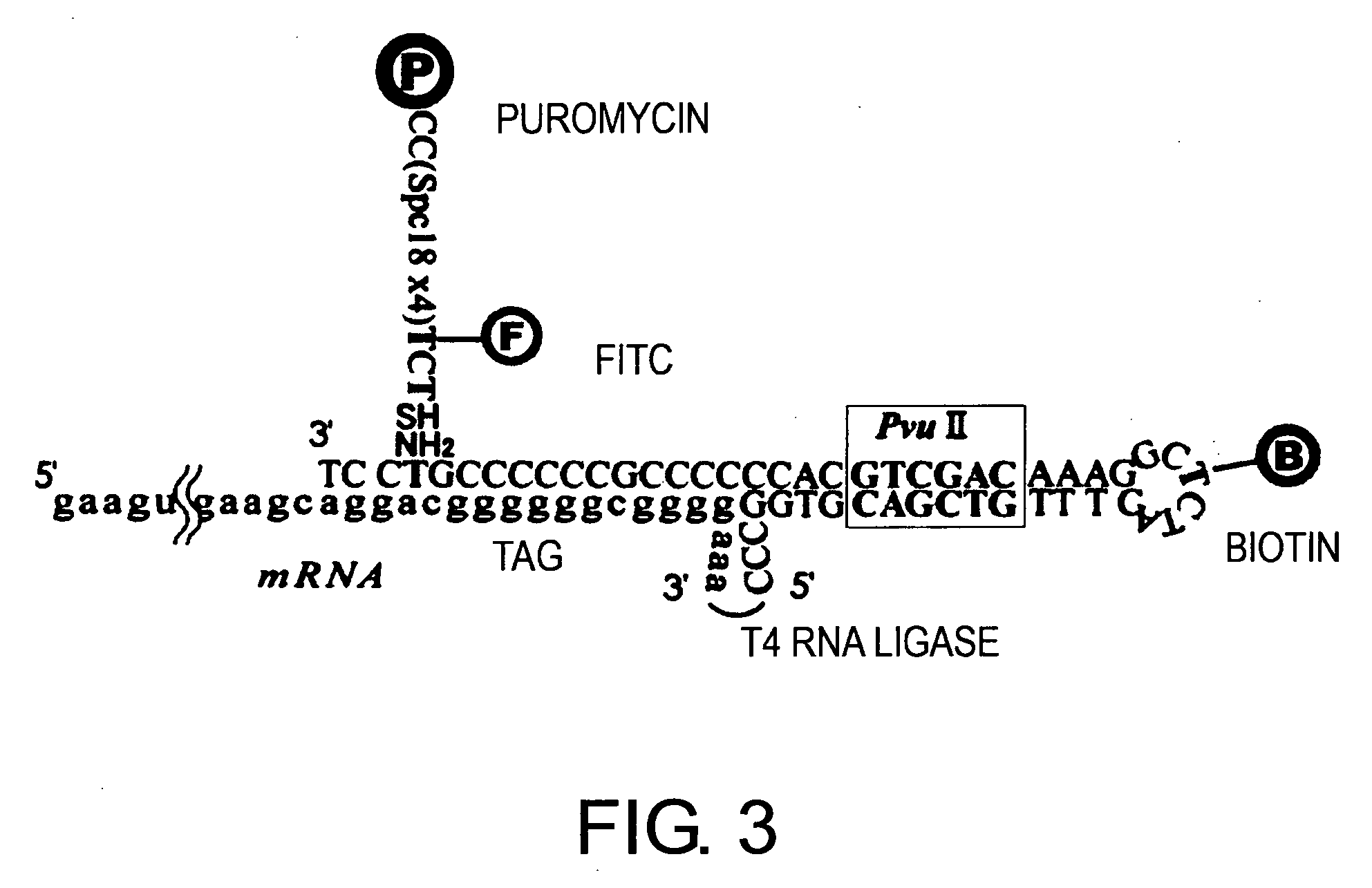Methods of screening for useful proteins
a protein and protein technology, applied in the field of methods of screening for useful proteins, can solve the problems of difficult tertiary structure analysis and difficult to achieve correct folding, and achieve the effect of easy degradation
- Summary
- Abstract
- Description
- Claims
- Application Information
AI Technical Summary
Benefits of technology
Problems solved by technology
Method used
Image
Examples
experimental example 1
1. Synthesis of Spacer BioLoop-Puro (Hereinafter Abbreviated as “PM-Attached Spacer DNA”)
[0148] 10 nmol of Puro-F-S [sequence: 5′-(S)-TC(F)-(Spec18)-(Spec18)-(Spec18)-(Spec18)-CC-(Puro)-3′; purchased from BEX] was dissolved in 100 μl of 50 mM phosphate buffer (pH7.0), and 1 μl of 100 mM Tris(2-carboxyethyl)phosphine hydrochloride (TCEP) was added (at a final concentration of 1 mM) thereto. The mixture was allowed to stand at room temperature for 6 hrs to reduce the thiol groups of Puro-F-S. Immediately before the cross-linking reaction, TCEP was removed using NAP5 (Amersham; 17-0853-02) that had been equilibrated with 50 mM phosphate buffer (pH7.0). In the sequence of Puro-F-S, “(S)” represents 5′-thiol-modifier C6; and “(Puro)” represents puromycin CPG “Spec18” represents the spacer (18-O-Dimethoxytritylhexaethyleneglycol, 1-[(2-cyanoethyl)-(N,N-diisopropyl)]-phosphoramidite) which is manufactured by Glen Research Search Co. and has the following chemical structure:
[0149] 20 μl...
experimental example 2
Preparation of Binding Peptides to Fluorescent Molecule Cy3
1. Synthesis of PM-Attached Spacer DNAs
[0172] PM-attached spacer DNAs were synthesized according to the method described in Experimental Example 1. FIG. 3 shows the schematic illustration of the method.
2. Library Construction for In Vitro Virus Synthesis
[0173] A full-length DNA library comprising random 57-bp sequences was prepared by ligating three single-stranded DNA fragments (SEQ ID NOs: 12 to 14) custom-synthesized at Fasmac Ltd. (FIG. 4). As shown in SEQ ID NOs: 12 to 14, fragments 1 and 2, and fragments 2 and 3, respectively, comprise 20- to 30-mer complementary sequences. Specifically, the full-length DNA library (SEQ ID NO: 15) was obtained by performing extension reactions in the order with fragments 2 and 3, and then with fragment 1. The extension reaction was achieved using Ex Taq (TaKaRa) under the condition of thermal denaturation at 95° C. for 2 min, followed by 18 cycles of thermal denaturation at 95° C...
PUM
| Property | Measurement | Unit |
|---|---|---|
| Force | aaaaa | aaaaa |
Abstract
Description
Claims
Application Information
 Login to View More
Login to View More - R&D
- Intellectual Property
- Life Sciences
- Materials
- Tech Scout
- Unparalleled Data Quality
- Higher Quality Content
- 60% Fewer Hallucinations
Browse by: Latest US Patents, China's latest patents, Technical Efficacy Thesaurus, Application Domain, Technology Topic, Popular Technical Reports.
© 2025 PatSnap. All rights reserved.Legal|Privacy policy|Modern Slavery Act Transparency Statement|Sitemap|About US| Contact US: help@patsnap.com



